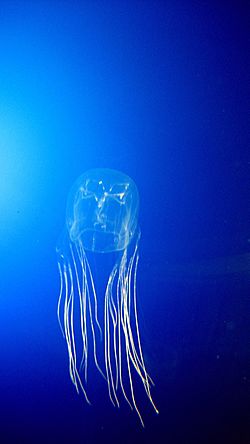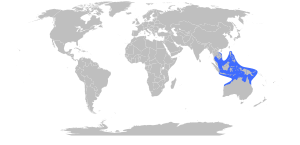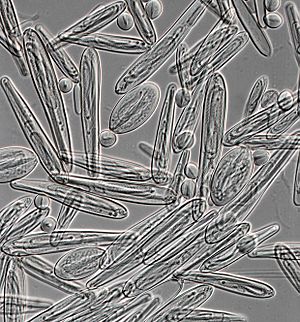Sea wasp facts for kids
Quick facts for kids Chironex fleckeri |
|
|---|---|
 |
|
| Chironex sp. | |
| Conservation status | |
|
Not evaluated (IUCN 3.1)
|
|
| Scientific classification | |
| Kingdom: | |
| Phylum: | |
| Class: | |
| Order: |
Chirodropida
|
| Family: |
Chirodropidae
|
| Genus: |
Chironex
|
| Species: |
C. fleckeri
|
| Binomial name | |
| Chironex fleckeri Southcott, 1956
|
|
 |
|
| Range of Chironex fleckeri as traditionally defined, but see text. | |
The Chironex fleckeri is a type of box jellyfish. It is also known as the Australian box jelly or sea wasp. This jellyfish is famous for its very powerful sting.
You can find it in the ocean waters near northern Australia and New Guinea. It also lives near Malaysia, the Philippines, and Vietnam. Many people call it "the most deadly jellyfish in the world."
Its long tentacles can reach up to 3 meters (10 feet). These tentacles have millions of tiny stinging cells. When they touch something, these cells shoot out tiny darts. These darts release a very strong venom. A sting can cause extreme pain. If a large area of skin is stung, a person can become very sick quickly. The venom from one jellyfish is enough to harm many people.
Contents
About the Sea Wasp's Name
The Chironex fleckeri was named after a doctor. His name was Doctor Hugo Flecker. He was a toxicologist and radiologist from North Queensland, Australia.
In 1955, a young boy died after being stung. This happened in shallow water at Cardwell. Doctor Flecker found three types of jellyfish there. One was a box-shaped jellyfish. It had groups of tentacles on each corner.
Doctor Flecker sent this jellyfish to Doctor Ronald Southcott. Doctor Southcott was in Adelaide. In December 1955, he wrote an article about it. He said it was a new type of deadly box jellyfish. He named it Chironex fleckeri.
The name "Chironex" comes from Greek mythology. It refers to the centaur Chiron. The Latin word chiro means "hand." The Latin word nex means "murder." So, "Chironex" means "hand of death." This name describes the four tentacle clusters of the jellyfish. "Fleckeri" honors Doctor Flecker, who discovered it.
What the Sea Wasp Looks Like
The Chironex fleckeri is the biggest type of box jellyfish. Its bell, which is the main body, is usually about 16 cm (6 inches) wide. But it can grow up to 35 cm (14 inches).
From each of the four corners of its bell, many tentacles hang down. There are about 15 tentacles in each cluster. The bell is a pale blue color. It has faint marks. From some angles, it can look a bit like a human head or skull.
This jellyfish is almost clear. This makes it very hard to see in the water. This is why it is so dangerous for swimmers.
Tentacles and Stinging Cells
When the jellyfish swims, its tentacles pull in. They become about 150 mm (6 inches) long. They are about 5 mm (0.2 inches) wide. When the jellyfish is hunting, its tentacles stretch out. They can become very thin and reach about 3 meters (10 feet) long.
The tentacles are covered with many stinging cells. These are called cnidocytes. They are activated by touch and by certain chemicals. They react to proteins.
Eyes and Hunting Habits
Like other box jellyfish, C. fleckeri has four groups of eyes. It has 24 eyes in total. Some of these eyes can form images. But scientists are not sure if they can recognize objects. They also don't know how the jellyfish uses information from its touch or eyes. This is because it does not have a central nervous system.
These jellyfish hunt during the day. At night, they rest on the ocean floor. They are attracted to different colors of light. Blue light seems to make them want to feed. It slows their pulsing and makes them stretch out their tentacles. They move away from black objects.
Diet and Predators
Chironex fleckeri eats prawns and small fish. Turtles are their main predators. Turtles have thick skin. This skin protects them from the jellyfish's stinging cells.
Where the Sea Wasp Lives

The Chironex fleckeri lives in the open ocean. It has been found in coastal waters. These include northern Australia and New Guinea. It also lives north to the Philippines and Vietnam.
In Australia, it is found along the northern coasts. This stretches from Exmouth to Agnes Water. Its full range outside Australia is not fully known. Another similar jellyfish, Chironex yamaguchii, was found in Japan in 2009. This species has also been seen in the Philippines. This means some old records of C. fleckeri outside Australia might actually be C. yamaguchii.
These jellyfish reproduce in the lower parts of rivers. They also breed in mangrove channels.
The Sea Wasp's Sting
The Chironex fleckeri is famous for its very strong sting. This sting can sometimes be deadly. The sting causes extreme pain. It feels like a burning sensation, like being branded with a hot iron. In Australia, the largest jellyfish cause most deaths.
Since 1883, at least 64 deaths in Australia have been linked to C. fleckeri. However, most stings are not deadly. From 1991 to 2004, 225 stings were studied in Australia. Only 8% of people needed to go to the hospital. 5% received antivenom. There was only one death, which was a 3-year-old child. About 26% of people felt severe pain. The rest felt moderate or no pain.
Most deaths in recent years have been children. This is because their smaller bodies are more affected by the venom. When people die, it is usually from a cardiac arrest. This can happen within minutes of the sting. It takes about 3 meters (10 feet) of tentacle contact to deliver a deadly amount of venom.
The venom makes cells leaky. This causes a chemical imbalance in the body. This can lead to heart problems and death very quickly. Sometimes, swimmers who are stung have a cardiac arrest. They might drown before they can get back to shore or a boat.
Staying Safe from Stings
Chironex fleckeri and other jellyfish are common in northern Australia. They are most common during the warmer months. They are thought to drift into river mouths to breed.
Warning signs are put up along the coast of North Queensland. These signs warn people about the jellyfish. Few people swim during this time. But some people still do, which is very risky.
At popular swimming spots, special nets are put in the water. People can swim inside these nets. The nets keep the jellyfish out, helping swimmers stay safe.
How Stings Are Treated
For a long time, people used pressure bandages to treat stings. The idea was to stop the venom from spreading. But this treatment is no longer suggested by health experts. Research showed that pressing on the sting could make more stinging cells release venom.
Now, applying vinegar is the recommended treatment. Vinegar (which is 4–6% acetic acid) stops the stinging cells that have not yet fired. This prevents them from opening and releasing more venom.
A study in 2014 suggested that vinegar might also cause some venom to be released from cells that had already fired. However, this study was criticized. The experiment used a simple model that was not like human skin. Also, it was not clear if the venom increase was from more venom being released or just leaking out. Despite these concerns, diluted acetic acid (vinegar) is still the recommended first aid.
Images for kids
See also
 In Spanish: Avispa de mar para niños
In Spanish: Avispa de mar para niños



